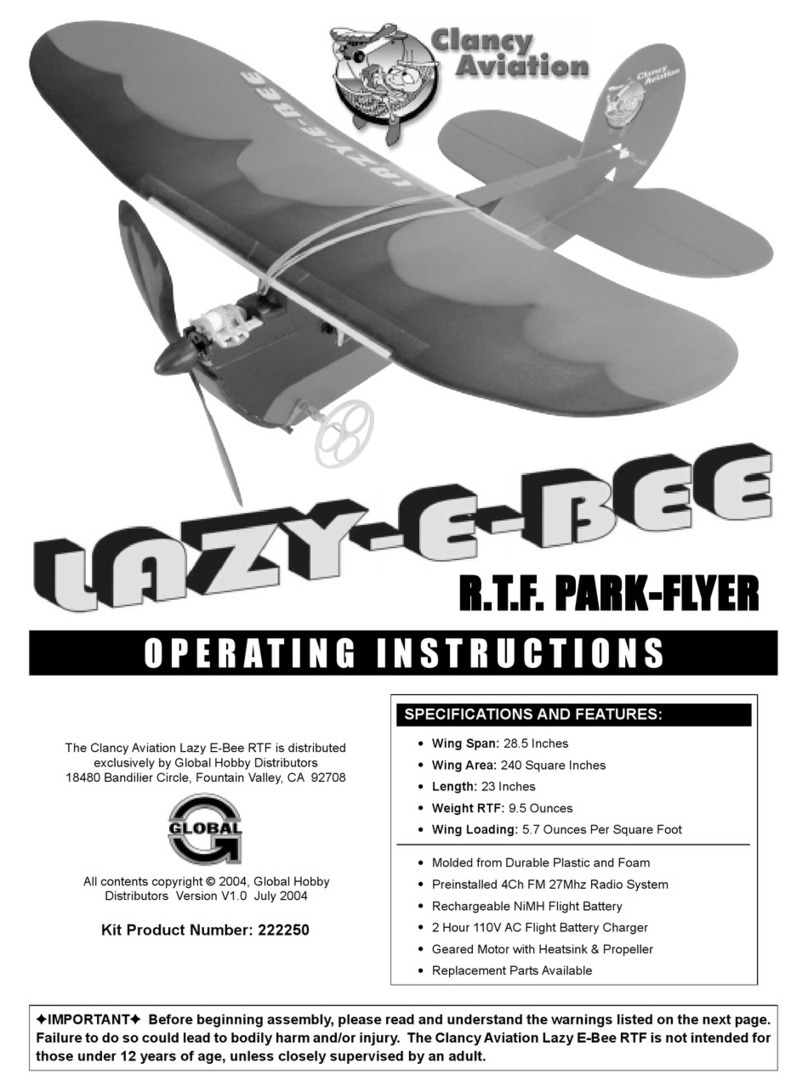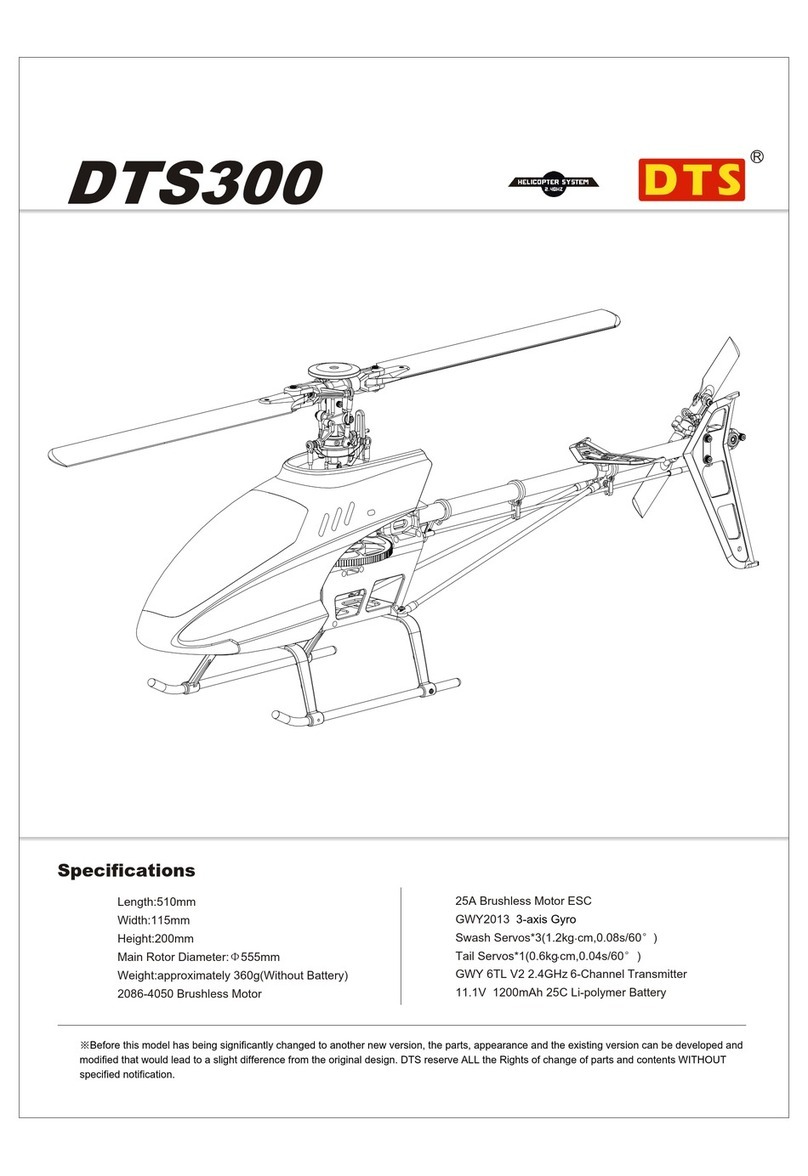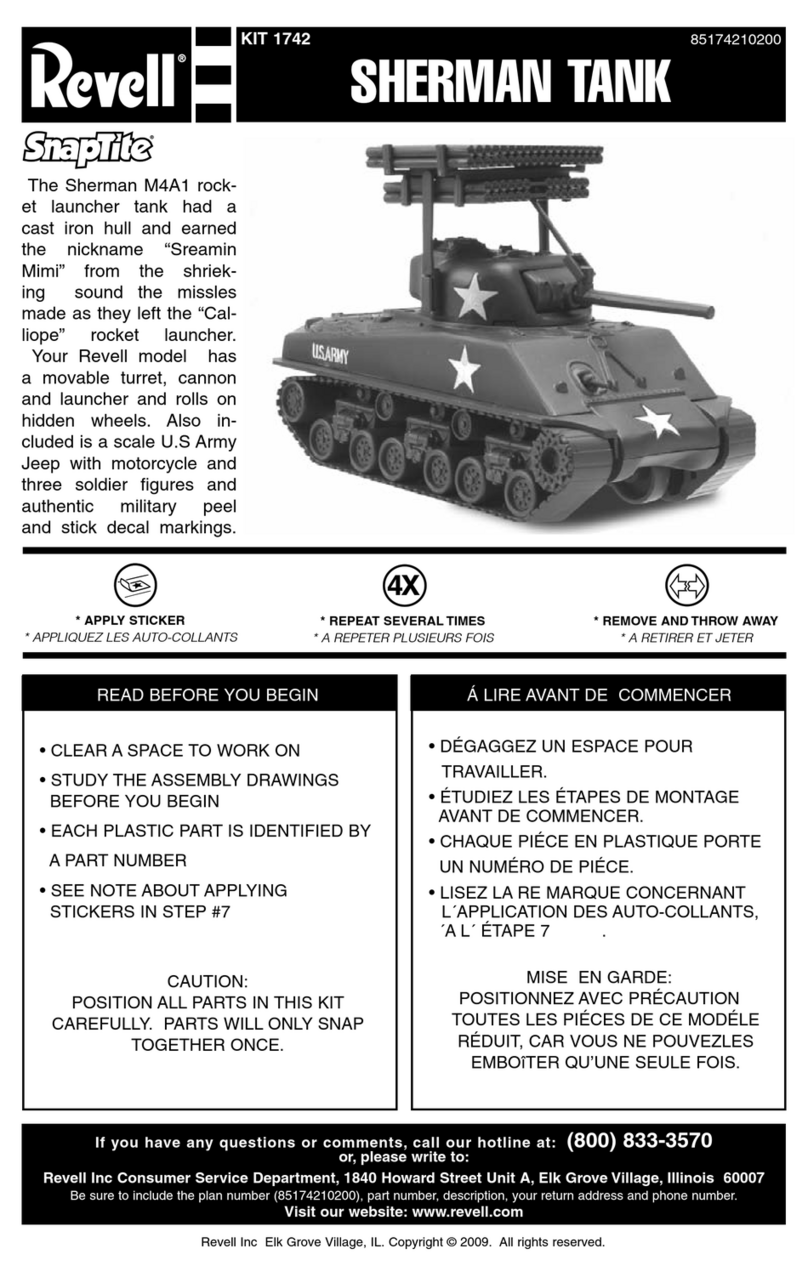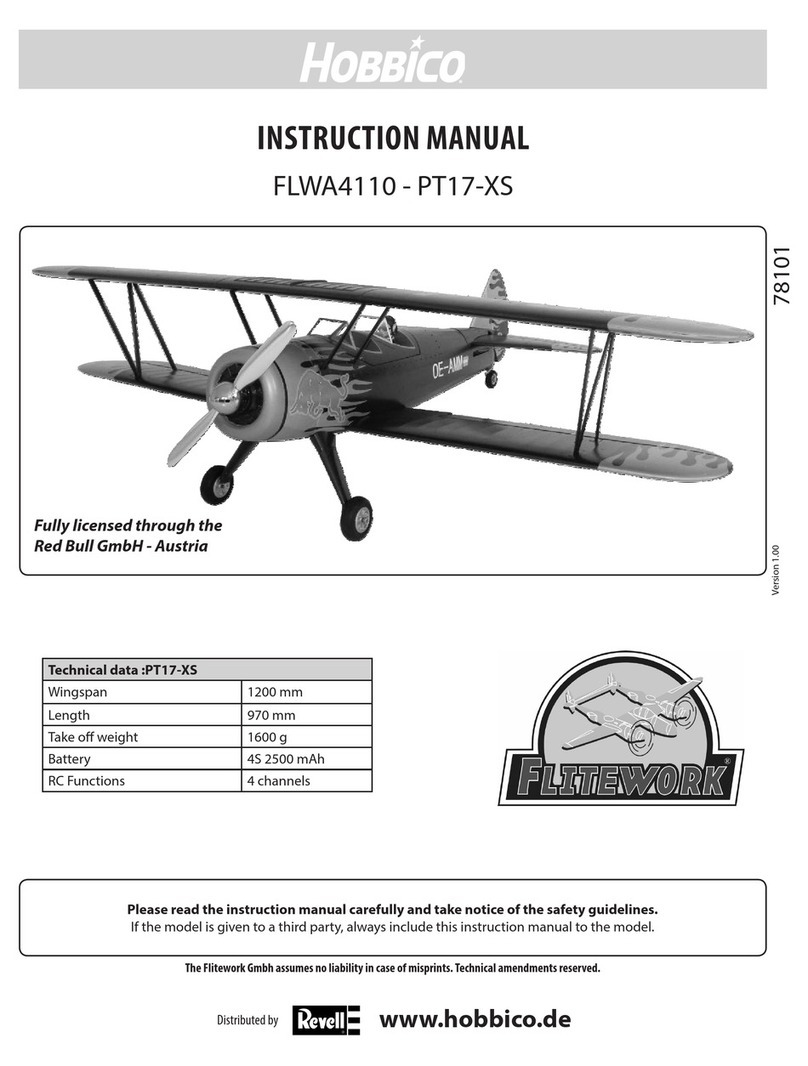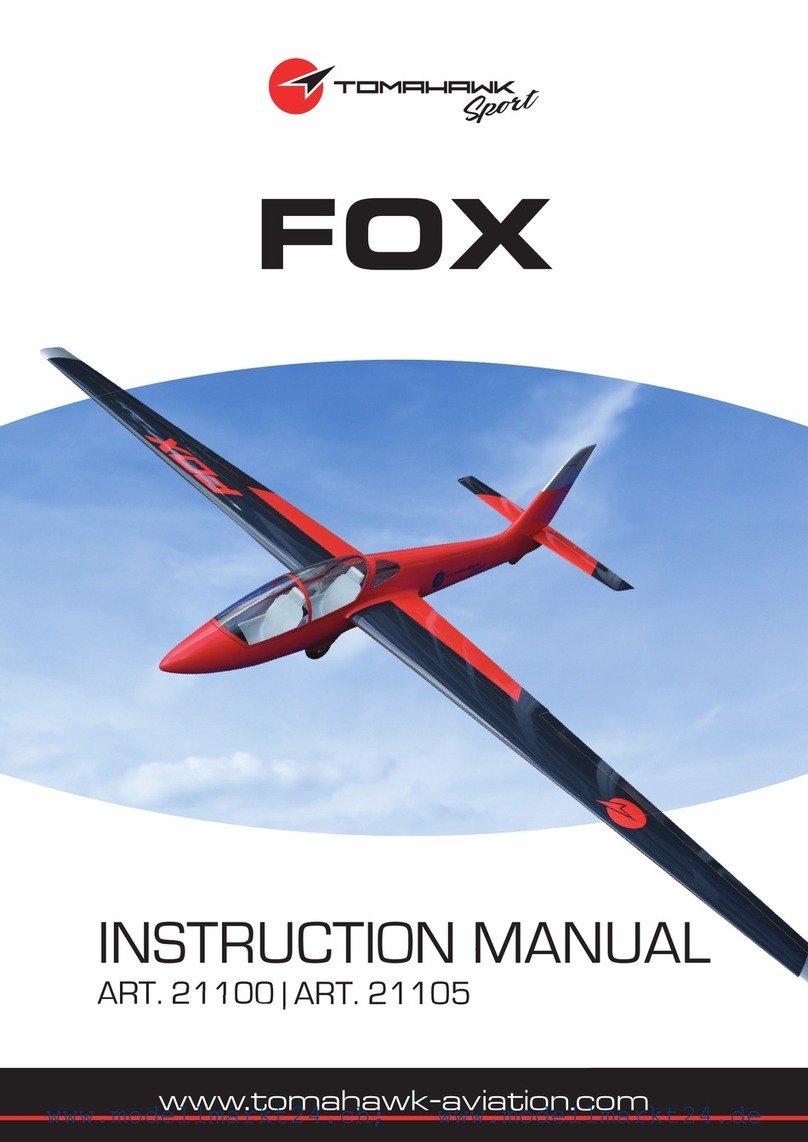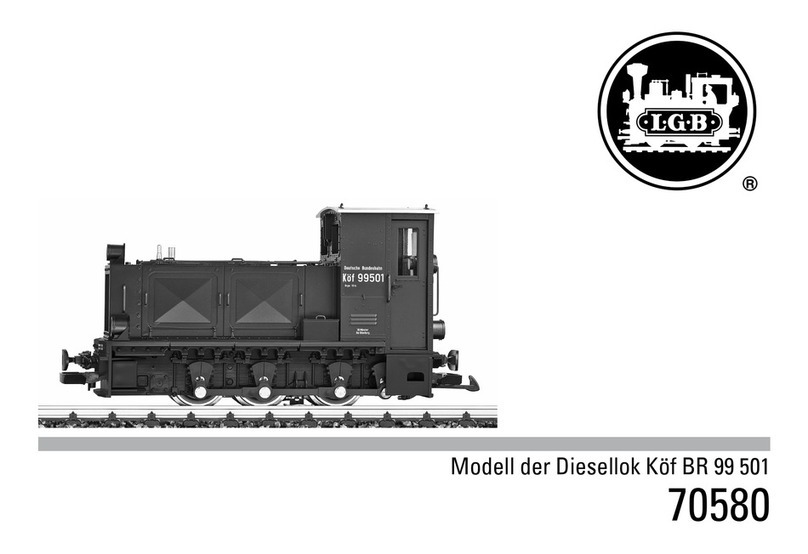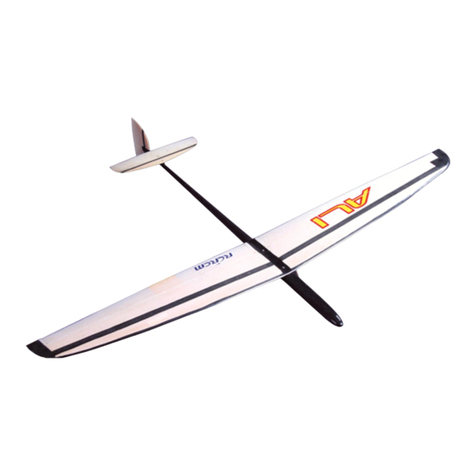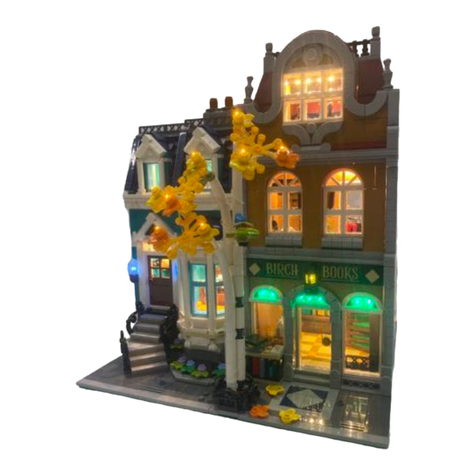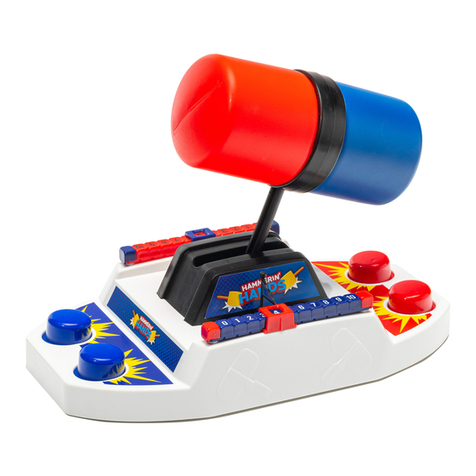Clancy Aviation speedy bee Assembly instructions

1
SPEEDY BEE ARF SPECIFICATIONS:
●Wing Span: 52 Inches (1315mm)
●Wing Area: 596 Square Inches (38.6dm2)
●Length: 37 Inches (940mm)
●Weight RTF: 49 Ounces (1400gr)
●Wing Loading: 12 Ounces/Square Foot (36.27gr/dm2)
●Functions: Ailerons, Elevator, Rudder and Throttle
●Engine Required: .20 - .28 Two-Stroke or .20 - .30 Four-Stroke
●Radio Required: 4 Channel or More w/5 Micro Servos and Micro RX
Recommended Electric Power System:
●Multiplex Brushless BL480/4G with APC 10 x 7E Propeller
●3C or More LiPO Flight Battery with 40 Amp ESC
INSTRUCTIONS FOR ASSEMBLY
Kit Product Number 222210
Andy's sporty mid-wing
Bee is now available
as an ARF: the Speedy
Bee Almost Ready-to-
Fly. This design was
originally reviewed in the
June 1998 RCM. Since
then, Clancy Aviation has
made several upgrades, making
this one of Andy's favorite ARFs
so far! We've added an access
door to the bottom of the fuselage
to make battery installation easier if flying it as an electric. It still
features the rubber band retained wing and now has the engine mounted
to the fuselage. We also eliminated the aileron bellcrank linkage and now use
separate aileron servos for each aileron, allowing pilots with computer radios and
mixing to be able to experiment with aileron/flap mixes. The construction itself is all laser-cut
and built on special jigs for precision. This provides superior alignment and performance. And we ONLY use REAL iron-on
covering material.
The Speedy Bee ARF is a 4-channel, mid-wing, wood-airframe design that resembles a golden age racer. The wing span is 52"
with a huge chord like the Lazy Bee. The Speedy Bee ARF wing is flat across the top, but gets some dihedral benefit from the
bottom surface taper. The ailerons are very large (often referred to as "barn door" ailerons) for better control at slow speeds, yet
the Speedy Bee ARF is our most aerobatic Bee: side slips, inverted flight, knife-edges and spins are possible. It's fast, fun, and
unique. It's the Speedy Bee ARF!
The Clancy Aviation Speedy Bee ARF is distributed
exclusively by Global Hobby Distributors
18480 Bandilier Circle, Fountain Valley, CA 92708
All contents copyright © 2005, Global Hobby Distributors
Version V1.0 February 2005

2
TABLE OF CONTENTS
This R/C airplane is not a toy! If misused or abused, it can cause serious bodily injury and/or damage to property. Fly only in open
areas and preferably at a dedicated R/C flying site. We suggest having a qualified instructor carefully inspect your airplane before
its first flight. Please carefully read and follow all instructions included with this airplane, your radio control system and any other
components purchased separately.
OUR GUARANTEE
Clancy Aviation guarantees this kit to be free from defects in both material and workmanship at the date of purchase. This does not cover
any component parts damaged by use, misuse or modification. In no case shall Clancy Aviation's liability exceed the original cost of
the purchased kit.
In that Clancy Aviation has no control over the final assembly or material used for final assembly, no liability shall be assumed for any damage
resulting from the use by the user of the final user-assembled product. By the act of using the final user-assembled product, the user accepts all
resulting liability.
FOR YOUR INFORMATION
To make your modeling experience totally enjoyable, we recommend that you get experienced, knowledgeable help with assembly and during
your first flights. Your local hobby shop has information about flying clubs in your area whose membership includes qualified instructors. If there
is no hobby shop in your area, we recommend that you contact the AMA at the address below. They will be able to help you locate a flying field
near you.
Academy of Model Aeronautics
5151 East Memorial Drive
Muncie IN 47302-9252
(800) 435-9262
www.modelaircraft.org
SAFETY WARNING
Check out our website for more information on
this and other exciting Clancy Aviation products!
http://clancyaviation.globalhobby.com
Safety Warning ...................................................................................... 2
Introduction ............................................................................................ 3
Customer Service Information .............................................................. 3
Section 1: Our Recommendations ....................................................... 4
Section 2: Tools and Supplies Required ............................................. 5
Section 3: A Note About Covering ....................................................... 5
Section 4: Kit Contents ........................................................................ 6
Section 5: Lithium Polymer Battery Warnings ..................................... 7
Section 6: Wing Assembly ................................................................... 8
Section 7: Wing Mounting .................................................................. 10
Section 8: Wing Deck Installation ...................................................... 13
Section 9: Horizontal Stabilizer Installation ....................................... 15
Section 10: Control Surface Hinging ................................................. 17
Section 11: Landing Gear Installation ................................................ 21
Section 12: Engine Installation .......................................................... 22
Section 13: Throttle Control System Installation ............................... 25
Section 14: Fuel Tank Assembly and Installation .............................. 27
Section 15: Elevator Control System Installation .............................. 29
Section 16: Rudder Control System Installation ............................... 31
Section 17: Aileron Control System Installation ................................ 32
Section 18: Final Assembly ................................................................ 34
Section 19: Balancing the Speedy Bee ARF ..................................... 36
Section 20: Control Throws ............................................................... 36
Section 21: Preflight Check and Safety ............................................. 37
Section 22: Replacement Parts ......................................................... 37
Section 23: Electric Motor, ESC and Battery Installation .................. 38
Product Evaluation Sheet ................................................................... 43

3
Thank you for purchasing the Clancy Aviation Speedy Bee ARF. Before completing the final assembly of your new
airplane, please carefully read through this instruction manual in its entirety. Doing so will ensure your success the
first time around!
SPEEDY BEE ARF FEATURES
●Prebuilt from High-Quality Balsa and Light Plywood
●Detailed, Laser-Cut Parts to Maximize Weight Reduction
●Precovered with Real Iron-On, Heat-Shrink Covering Material
●Can be Flown with Glow Power or Electric Power - Hardware Included for Both!
●Classic Bee-Style Shock-Absorbing Main Landing Gear with Steerable Tail Wheel
●Dual Aileron Servos for Crisp Roll Response
●Includes a High-Quality Hardware Package
●Fast and Easy Assembly - Over 80 High-Resolution Digital Photos and Drawings to Guide You
This instruction manual is designed to guide you through the entire assembly process of your new airplane in the least amount of
time possible. Along the way you'll learn how to properly assemble your new airplane and also learn tips that will help you in the
future. We have listed some of our recommendations below. Please read through them before beginning assembly.
●Please read through each step before beginning assembly.
You should find the layout very complete and straightforward.
Our goal is to guide you through assembly without any of the
headaches and hassles that you might expect.
●There are check boxes next to each procedure. After you
complete a procedure, check off the box. This will help prevent
you from losing your place.
●Cover your work table with brown paper or a soft cloth, both
to protect the table and to protect the parts.
●Keep a couple of small bowls or jars handy to put the small
parts in after you open the accessory bags.
●We're all excited to get a new airplane in the air, but take your
time. This will ensure you build a straight, strong and great
flying airplane.
●If you come across this symbol ☞, it means that this is an
important point or an assembly hint.
If you should find a part missing or damaged, or have any questions about assembly, please contact us at the address below:
To enable us to better serve your needs, please include your email address with any correspondence you send to us. Your email
address will be added to our Customer Service Database so you will automatically receive free updates and tech notices for your
particular product. You will also receive repair status updates (if applicable) and other important information about your product
as it becomes available.
IMPORTANT INFORMATION ABOUT YOUR EMAIL ADDRESS
INTRODUCTION
CHECK IT OUT! We urge you to come check out our website at http://globalservices.globalhobby.com. There you will find public message
boards frequented by other Clancy Aviation product owners and the Global Services support staff. This is a great place to learn about new
products, get help and suggestions for your product or just simply hang out and chat with people that share your same interests.
Global Hobby Distributors will not disclose the information it collects to outside parties. Global Hobby Distributors
does not sell, trade, or rent your personal information to others . Your privacy is important to us.
CUSTOMER SERVICE INFORMATION
Global Services
18480 Bandilier Circle
Fountain Valley, CA 92708
Phone: (714) 963-0329
Fax: (714) 964-6236
Email: service@globalhobby.net

4
This section describes our recommendations to help you in deciding which types of accessories to purchase for your new
Clancy Aviation Speedy Bee ARF.
Please read through this entire section very carefully. We have provided you with tips and recommendations that, if
followed, will result in a great flying airplane. Failure to follow our recommendations may result in a poor flying airplane.
SECTION 1: OUR RECOMMENDATIONS
What Engine Should I Use?
What Radio System and Servos Should I Use?
You will need to use a four or more channel radio control system with five mini servos and a
lightweight receiver. A standard four-channel radio or a more sophisticated computer radio would
work equally well. Using a computer radio will allow you to plug each aileron servo separately into
the receiver, allowing you the capability of aileron to flap mixing for outrageous control response.
The Speedy Bee ARF is a small, lightweight airplane, so using mini servos is required. We suggest
using servos that weight no more than 23 grams and have a torque rating of approximately 30oz/sq.in.
What Else Do I Need?
There really isn't much else that you'll need to finish the airplane. Most of the hardware is included in the kit, so
about the only thing else you'll need is a spinner, two servo extension leads and a Y-Harness (if you're not using
mixing). You'll also need typical modeling supplies, such as foam rubber to protect your receiver and battery,
and fuel tubing. You may need a soldering iron, solder and other related supplies if you're using electric power.
Suggested Setup for Electric Flight - See Our Separate Recommendations on Next Page
We know that many customers will want to power their Speedy Bee ARF with an electric power
system, rather than a glow engine. For the most power, lightest weight and best performance, we
suggest using a geared brushless motor, such as the Multiplex BL480/4G with 4.4:1 gearbox,
APC 10 x 7E propeller, M'Troniks 40 amp brushless ESC and WattAge 3 cell 2000mAH LiPO flight pack.
BECAUSE YOU'LL BE USING A BRUSHLESS MOTOR, YOU WILL NEED TO USE A BRUSHLESS MOTOR CONTROLLER,
COMPATIBLE WITH THE MOTOR YOU'VE CHOSEN. DO NOT ATTEMPT TO USE AN ESC DESIGNED FOR BRUSHED
MOTORS WITH A BRUSHLESS MOTOR.
QTY. 1 210630 Magnum XL .28A Two-Stroke Engine
QTY. 1 237152 Magnum 2" Aluminum Spinner w/Adapter Nut
QTY. 1 608360 APC 9 x 6 Propeller
QTY. 5 444245 Cirrus CS-18 Mini Servos
QTY. 2 444713 Cirrus 12" Servo Extensions
QTY. 1 115493 Thunderbolt R/C Long Glow Plug
QTY. 1 115923 Global XX Silicone Fuel Tubing
QTY. 1 868638 Dubro 1/4" Protective Foam Rubber
QTY. 1 867903 Dubro 3/8" Heat-Shrink Tubing
QTY. 1 925040 Beacon # 64 Rubber Bands
Here's a List of What We Used to Finish Our Speedy Bee ARF
✦✦
✦✦
✦IMPORTANT✦✦
✦✦
✦The part number for the Cirrus servos is compatible with all name-brand radio control systems. These servos use a universal
connector. The part number for the Cirrus servo extensions are compatible with Hitec and JR radio control systems. This item is also available
with connectors that are compatible with Futaba and Airtronics radio control systems.
The Speedy Bee ARF is designed to use a .20 - .28 size two-stroke engine or a .20 - .30 size four-stroke engine.
The airplane flies great using engines within the recommended size ranges, although for the
most speed and best aerobatic performance we suggest using an engine at the upper end of the
size range.
We don't suggest using engines larger than those recommended. A larger engine will
typically weigh more and this extra weight could have a negative effect on the airplane's
flight characteristics. A larger engine may also be physically too big to mount onto the firewall.
IF YOU'RE FLYING AT HIGHER ALTITUDES, WE RECOMMEND USING AN ENGINE AT THE HIGH END OF THE RECOMMENDED SIZE RANGE.

5
❑Ernst Airplane Stand # 223977
❑Ruler
❑Pencil
❑Dubro T-Pins # 567677
❑Builder's Triangle
❑220 Grit Sandpaper w/Sanding Block
❑Masking Tape
❑Paper Towels
❑Wax Paper
❑Petroleum Jelly
❑Rubbing Alcohol
❑NHP Epoxy Mixing Sticks # 864204
❑NHP Epoxy Mixing Cups # 864205
❑Global Heat Gun # 360920
❑Global Heat-Sealing Iron # 360900
The covering material used on the Clancy Aviation Speedy Bee ARF is real iron-on, heat-shrink covering material. It is possible with
heat and humidity changes that the covering on your airplane may wrinkle or sag. This trait is inherent in all types of heat-shrink
material. To remove any wrinkles that might be visible you will need to use a heat-sealing covering iron.
Follow this simple procedure to remove the wrinkles:
❑Plug in and turn on the sealing iron to the medium-high temperature setting. Allow the sealing iron to heat up for approximately
5 - 7 minutes.
❑After the sealing iron has reached temperature, lightly apply the sealing iron to the wrinkled section of the covering. Move the
sealing iron slowly over the wrinkled section until the covering tightens and the wrinkles disappear.
☞If the color layer smears from any of the seams the temperature of the sealing iron is too hot. Turn the temperature dial down
and wait about 5 minutes for the sealing iron to adjust to the lower temperature. You can remove any excess color streaks using a
paper towel soaked with a small quantity of Acetone.
We do not suggest storing your airplane in an extremely hot environment (like the back of your car in direct sunlight)
for any length of time. The extreme heat could cause the covering material to wrinkle and possibly damage the fragile components
of the radio control system.
❑Kwik Bond Thin C/A # 887500
❑Kwik Bond Thick C/A # 887510
❑Kwik Bond 5 Minute Epoxy # 887560
❑Kwik Bond 30 Minute Epoxy # 887565
❑Kwik Bond C/A Debonder # 887545
❑Wilhold Silicon Sealant # 335407
❑#1 & #2 Phillips Head Screwdrivers
❑2.5mm Hex Wrench
❑Wire Cutters
❑Needle Nose Pliers
❑Adjustable Wrench
❑Excel Modeling Knife # 692801
❑Scissors
❑Electric Drill
❑Assorted Drill Bits
SECTION 2: TOOLS AND SUPPLIES REQUIRED
The tools and supplies listed below will be necessary to finish the assembly of your new Clancy Aviation Speedy Bee ARF. We
suggest having these items on hand before beginning assembly.
SECTION 3: A NOTE ABOUT COVERING
QTY. 1 240030 Multiplex BL480/4G Brushless Motor w/Gear Box
QTY. 1 128783 Wattage 3C 2000mAH LiPO Flight Battery
QTY. 1 157276 M'Troniks Genesis 40A Brushless ESC
QTY. 1 608473 APC 10 x 7E Composite Propeller
QTY. 4 444245 Cirrus CS-18 Mini Servos
QTY. 2 444713 Cirrus 12" Servo Extensions
QTY. 1 867903 Dubro 3/8" Heat-Shrink Tubing
QTY. 1 925040 Beacon # 64 Rubber Bands
Recommended Items for Brushless Electric Power
PRO TIP
The LiPO battery that you choose MUST be able to handle the current draw of your motor, gear box and propeller
combination. Before charging or otherwise using your LiPO battery pack, please read all warnings included with it.
Smaller capacity LiPO flight batteries may be too light to balance the airplane properly. In this case, it may be necessary
to add some nose weight to balance the airplane.

6
We have organized the parts as they come out of the box for easier identification during assembly. Before you begin assembly,
group the parts as we list them below. This will ensure that you have all of the parts before you begin assembly and it will also help
you become familiar with each part.
If you find any parts missing or damaged, please contact us as soon as possible, using the Customer Service
Information on page # 3. A complete replacement parts list can be found on page # 37.
SECTION 4: KIT CONTENTS
AIRFRAME ASSEMBLIES
❑(1) Fuselage
❑(1) Center Wing Panel
❑(1) Left Wing Tip Panel w/Aileron
❑(1) Right Wing Tip Panel w/Aileron
❑(1) Horizontal Stabilizer w/Elevator
❑(1) Rudder
❑(1) 6-1/8" Threaded Wire w/Z-Bend
❑(1) Nylon Control Horn w/Backplate
❑(1) Nylon Clevis
❑(2) M2 x 12mm Machine Screws
❑(1) C/A-Style Hinge
RUDDER CONTROL SYSTEM
LANDING GEAR ASSEMBLY
❑(1) Steel Axle
❑(1) Aluminum Tube
❑(2) Main Gear Wheels
❑(2) Nylon Spacers
❑(2) Wheel Collars
❑(2) M3 x 6mm Machine Screws
❑(2) Rubber Bands
AILERON CONTROL SYSTEM
❑(2) 3-3/8" Threaded Wires w/Z-Bends
❑(2) Nylon Control Horns
❑(2) Nylon Clevises
❑(4) M2 x 10mm Wood Screws
❑(8) Nylon Steel-Pinned Hinges
ELEVATOR CONTROL SYSTEM
❑(1) 5-1/2" Threaded Wire w/Z-Bend
❑(1) Nylon Control Horn w/Backplate
❑(1) Nylon Clevis
❑(2) M2 x 12mm Machine Screws
❑(6) C/A-Style Hinges
ENGINE MOUNT ASSEMBLY
❑(2) Engine Mounting Beams
❑(4) M3 x 18mm Machine Screws
❑(4) M3 x 25mm Socket-Cap Screws
❑(4) M3 Lock Nuts
❑(4) M3 Blind Nuts
❑(12) M3 Flat Washers
❑(1) Prebent Tail Wheel Wire w/Nylon Bearing
❑(1) Tail Wheel
❑(1) Nylon Spacer
❑(1) Wheel Collar
❑(1) M3 x 5mm Machine Screw
TAIL WHEEL ASSEMBLY
❑(1) 11-3/4" Plain Wire w/Z-Bend
❑(1) Adjustable Pushrod Connector w/Machine Screw & Nut
THROTTLE CONTROL SYSTEM
❑(1) 85cc Fuel Tank
❑(1) Large Diameter Metal Plate
❑(1) Small Diameter Metal Plate
❑(1) Neck-Reinforcement Ring
❑(1) Rubber Stopper
❑(1) Fuel Pick-Up "Clunk"
❑(1) M3 x 20mm Machine Screw
❑(1) Silicone Fuel Tubing
❑(3) Aluminum Tubing
FUEL TANK ASSEMBLY
MISCELLANEOUS FUSELAGE PARTS
❑(2) Hardwood Dowels
❑(2) Plywood Mounting Plates (Optional)
❑(1) Plastic Windscreen
❑(5) M2 x 5mm Wood Screws
❑(2) M2 x 10mm Flange-Head Wood Screws
❑(1) Clear Vinyl Tubing
❑(1) Decal Set
MISCELLANEOUS WING PARTS
❑(1) Front Wing Deck
❑(1) Rear Wing Deck
❑(4) Plywood Rubber Band Doublers
OPTIONAL ELECTRIC MOTOR MOUNT ASSEMBLY
❑(4) Motor Mounting Straps
❑(4) M3 x 12mm Wood Screws
❑(4) M3 Flat Washers

7
SECTION 5: LITHIUM POLYMER BATTERY WARNINGS - PLEASE READ
If you will be powering your Speedy Bee ARF with an electric motor and are using a lithium polymer flight
battery, please read and understand the warnings listed in this section. Also make sure to read any and all
warnings included in the packaging with your battery. If used improperly, lithium polymer batteries can be very
dangerous, so please follow these warnings and suggestions at all times.
WARNINGS AND SAFETY PRECAUTIONS FOR ALL BRANDS OF LITHIUM POLYMER BATTERIES
●This product may explode or catch fire. Serious injury can result from misuse. Serious injury, loss of property, fire and death
can result from misuse of this product.
●All instructions, warnings and cautions must be followed at all times. Failure to do so can lead to serious injury or fire.
●Do NOT use this product before reading and understanding all directions and warnings.
●Do NOT overcharge. Maximum voltage for each pack must be followed.
●Do NOT over-discharge. NEVER discharge below minimum volts.
●Do NOT discharge at a rate greater than the maximum continuous discharge.
●Do NOT use or charge if the battery is hot.
●ONLY use a charger made for Lithium Polymer batteries.
●Do NOT charge at a rate higher than 1C. Example: if the battery’s rating is 340mAH, then the charger’s charge rate must be set
at 340mAH or less.
●Do NOT leave in direct sunlight or in a hot car or storage area.
●Do NOT get wet or expose to moisture.
●Do NOT short-circuit the battery.
●ONLY discharge and charge the battery outdoors or in a fire-safe container.
●Do NOT charge with reverse polarity.
●Do NOT leave the battery connected when not in use.
●Do NOT operate or charge unattended.
●Do NOT solder to the battery directly and do not get the battery hot in any way.
CHARGING PRECAUTIONS FOR ALL BRANDS OF LITHIUM POLYMER BATTERIES
●Do NOT use the product if you do not understand the warnings and proper use of the product.
●Always let the battery cool and "rest" between uses and charging.
●To avoid over-discharging, only use a speed control that is made for LiPO batteries.
●We recommend the use of a fire-safe container when charging or storing.
●Do NOT charge inside your car or inside your house.
●Inspect the battery before each use for swelling or other malformation. If the cell has ballooned, it MUST be discarded.
●Set the charger to 1C (charge at 1/2C or less for the first 5 cycles).
●Check polarity and then connect battery to charger.
●In use, do not to over-discharge or exceed maximum discharge.
●When handling the battery, remember not to poke, bend or damage the cell. The cell outer casing is soft and can be damaged.
●Remember, the cells must never exceed 160 degrees Fahrenheit for any reason.
You MUST use a LiPO-compatible
charger, like the WattAge Charge-It-All,
to charge LiPO batteries
P/N 130116

8Continued On Next Page
☛☛
☛☛
☛
❑Kwik Bond 30 Minute Epoxy
❑# 1 Phillips Head Screwdriver
❑Excel Modeling Knife
❑Electric Drill
❑1/16" Drill Bit
❑Ruler
❑(1) Center Wing Panel
❑(1) Left Wing Tip Panel w/Aileron
❑(1) Right Wing Tip Panel w/Aileron
❑Masking Tape
❑Paper Towels
❑Rubbing Alcohol
❑NHP Epoxy Mixing Sticks
❑NHP Epoxy Mixing Cups
❑Global Heat Gun
YOU'LL NEED THE FOLLOWING PARTS FROM THE KIT:
YOU'LL NEED THE FOLLOWING TOOLS AND SUPPLIES:
SECTION 6: WING ASSEMBLY
STEP 1: ALIGNING THE WING TIP PANELS
❑Remove the aileron and hinges from both wing tip panels and set them aside.
❑Using a modeling knife, cut away and remove the excess covering
material that overlaps onto the root ribs of each wing tip panel, leaving
about 1/16" overlapped so it does not pull away.
❑Repeat the previous procedure to remove the covering material from
both ends of the center wing panel.
✦✦
✦✦
✦IMPORTANT✦✦
✦✦
✦It's very important to the integrity of the glue joints that you remove as much covering material from the root
ribs and the ends of the center wing panel as possible. Do not omit this procedure or the wing joints may fail during flight.
❑Working with one wing tip panel for now, carefully test-fit the wing tip
panel onto the corresponding end of the center wing panel (without
using glue), making sure that the dowels in the wing tip panel engage
the holes in the center wing panel.
❑While holding the two wing panels together firmly, make sure that the wing panels are lined up at both the leading and trailing
edges, then look carefully at the glue joint: the wing panels should fit together tightly with few or no gaps in the joint.
✦✦
✦✦
✦IMPORTANT✦✦
✦✦
✦If the wing panels do not fit together properly, use 220 grit sandpaper with a sanding block to lightly sand
the root rib of the wing tip panel and/or the end of the center wing panel, until you are satisfied with the fit. Remember, when the
wing panels are pushed together, there should be few or no gaps in the glue joint.
❑Repeat the previous procedures to align and test-fit the other wing tip panel to the center wing panel.
❑When satisfied with the fit and alignment, remove the wing tip panels from the center wing panel and set them aside.

9Continued On Next Page
☛☛
☛☛
☛
❑Apply a strip of masking tape to the top and bottom edges of the root
rib on one wing tip panel and the top and bottom edges of the
corresponding end of the center wing panel.
☞The masking tape will prevent excess epoxy from getting onto the
wing panels when you join them.
❑Mix a generous amount of 30 minute epoxy and apply a thin layer to
the entire surface of BOTH root ribs, the two dowels in the wing tip
panel and into the holes in the center wing panel. Make sure to use
enough epoxy to fill any gaps.
STEP 2: JOINING THE WING PANELS
✦✦
✦✦
✦IMPORTANT✦✦
✦✦
✦It is of the utmost importance to the integrity of the glue joint that you apply a generous amount of epoxy to both
root ribs and the two dowels. Not using enough epoxy can result in wing failure during flight.
❑Slide the two wing panels together and realign them. Quickly wipe away any excess epoxy, using a paper towel and rubbing
alcohol, and use pieces of masking tape to hold the two wing panels aligned until the epoxy fully cures.
❑After the epoxy fully cures, repeat the previous procedures to glue the second wing tip panel to the center wing panel.
STEP 3: CHECKING THE GLUE JOINTS
❑Once the epoxy has fully cured, remove the masking tape and double-check both glue joints. If any gaps are present, mix a
small quantity of 30 minute epoxy and carefully fill any remaining gaps.
✦✦
✦✦
✦IMPORTANT✦✦
✦✦
✦Do not omit this procedure. All three wing panels should fit together tightly, but it's possible to have some small
gaps that appear in the glue joints after the epoxy has cured. To make the glue joints as strong as possible, it's important to fill any
gaps, using 30 minute epoxy.
STEP 4: INSTALLING THE AILERON SERVOS
❑Using a modeling knife, cut away and remove the covering material
from over the aileron servo lead exit hole in the bottom of the wing. The
center of the hole is 7-1/2" in front of the trailing edge and the hole is
2-3/8" wide and 3-3/4" long.
❑Using a modeling knife, cut away and remove the covering material
from over the two aileron servo mounting holes in the bottom of the
wing. The holes are located 1/2" in from the wing tip panel glue joints
and 3" in front of the trailing edge.

10
❑Plug one 12" servo extension onto the aileron servo lead.
❑To prevent the plugs from pulling apart during assembly, or worse,
during flight, secure the plugs together, using a short piece of 3/8"
diameter heat-shrink tubing. Use a heat gun to shrink the tubing tight.
❑Tie the end of the length of preinstalled string in the servo mounting
hole to the servo lead plug and use it to pull the servo lead through
the wing.
❑Set the servo into place, making sure that the servo output shaft is
toward the leading edge of the wing.
❑Install the aileron servo, making sure to drill 1/16" diameter pilot holes
for the mounting screws.
☞The servo hole is sized to fit most standard-size mini servos. You
may need to enlarge the hole slightly to fit your particular servo.
❑Repeat the previous procedures to install the second aileron servo into the wing.
☞Tie the end of the string to the servo lead plug at the servo mounting hole, then pull the string from the other end to guide the
servo lead out through the bottom of the wing.
❑Kwik Bond Thick C/A
❑Kwik Bond 5 Minute Epoxy
❑Excel Modeling Knife
❑Ruler
❑Pencil
❑(1) Fuselage
❑(2) Hardwood Dowels
❑(4) Plywood Rubber Band Doublers
❑Masking Tape
❑Paper Towels
❑Rubbing Alcohol
❑NHP Epoxy Mixing Sticks
❑NHP Epoxy Mixing Cups
YOU'LL NEED THE FOLLOWING PARTS FROM THE KIT:
YOU'LL NEED THE FOLLOWING TOOLS AND SUPPLIES:
SECTION 7: WING MOUNTING
Continued On Next Page
☛☛
☛☛
☛
❑Install the rubber grommets and brass collets onto one aileron servo, making sure to install the collets with the flanges toward
the bottom of the servo.

11
STEP 1: INSTALLING THE WING HOLD-DOWN DOWELS
❑Using a modeling knife, cut away and remove the covering material
from over the two precut wing hold-down dowel mounting holes behind
the wing saddle.
❑Test-fit one hardwood dowel into the fuselage. When aligned
properly, the dowel should be centered, so that the ends of the dowel
are equal distance from the fuselage sides.
Continued On Next Page
☛☛
☛☛
☛
❑When satisfied with the fit, glue the dowel into place, using a thin layer of 5 minute epoxy. Remove any excess epoxy, using a
paper towel and rubbing alcohol.
❑Repeat the previous procedures to install the second hardwood dowel
into the precut holes in front of the wing saddle.
STEP 2: INSTALLING THE RUBBER BAND DOUBLERS
❑Using a modeling knife, cut away and remove the covering material
from over the fuel tank support hatch in the top of the wing. The hatch
is 2-3/8" wide and 4-1/4" long.
☞One hole is located on each side of the fuselage, 5/16" below and 3/8" behind the wind saddle.
☞One hole is located on each side of the fuselage, 1/2" below and 1/4" in front of the wind saddle.

12
❑Set the wing into the wing saddle and carefully center it at both the
leading and trailing edges.
☞Push the wing as far forward as possible. There will be a narrow
gap between the trailing edge and the fuselage. This is normal and will
be filled by the rear wing deck.
❑When satisfied with the alignment, hold the wing firmly in place, using a couple of weights.
❑With the wing held firmly in place, position the two rear rubber band
doublers onto the top of the wing and align them. When aligned
properly, the back edge of the doublers should be even with the trailing
edge and the inside edge of the doublers should be even with or slightly
out from the sides of the fuselage.
❑When satisfied with the alignment, use a pencil to carefully trace an
outline around the two doublers onto the wing.
☞The two rear rubber band doublers are precovered in yellow to match the wing.
✦✦
✦✦
✦IMPORTANT✦✦
✦✦
✦It's important to make sure that the inside edge of each doubler is even with or slightly out from the sides of the
fuselage. This will ensure that the doublers will not interfere with the installation of the rear wing deck.
❑Remove the wing from the fuselage and use a modeling knife to
cut away and remove the covering material from within the outlines
you drew.
❑Using thick C/A, carefully glue the two rubber band doublers to the
wing. Allow the C/A to fully cure before proceeding.
✦✦
✦✦
✦IMPORTANT✦✦
✦✦
✦If any excess C/A gets onto the wing, it can be
removed promptly using a paper towel and C/A debonder.
Continued On Next Page
☛☛
☛☛
☛
❑Set the wing back into the wing saddle and realign it. Double-check to make sure that it's centered at both the leading and
trailing edges. Again, use a couple of weights to hold the wing firmly in place.

13
❑Repeat the previous procedures to install the two remaining rubber
band doublers onto the front of the wing.
✦✦
✦✦
✦IMPORTANT✦✦
✦✦
✦Remember, it's important that the inside edge of
the doublers be even with or slightly out from the fuselage sides. This
will ensure that the doublers will not interfere with the installation of
the front wing deck.
STEP 3: INSTALLING THE WING
❑Set the wing back into the wing saddle and realign it. Use two # 64
rubber bands per side to secure the wing into place.
✦✦
✦✦
✦IMPORTANT✦✦
✦✦
✦For flight you should hold the wing in place using a
minimum of six # 64 rubber bands per side.
❑Wilhold Silicon Sealant
❑Masking Tape
❑(1) Front Wing Deck ❑(1) Rear Wing Deck
❑Paper Towels
❑Wax Paper
YOU'LL NEED THE FOLLOWING PARTS FROM THE KIT:
YOU'LL NEED THE FOLLOWING TOOLS AND SUPPLIES:
SECTION 8: WING DECK INSTALLATION
STEP 1: INSTALLING THE FRONT WING DECK
Continued On Next Page
☛☛
☛☛
☛
❑Remove the wing, lay a long piece of wax paper over the wing saddle,
then reinstall the wing, making sure that the ends of the wax paper are
covering the joints between the fuselage and the leading and trailing
edges of the wing.
✦✦
✦✦
✦IMPORTANT✦✦
✦✦
✦It's important to use wax paper or plastic wrap when you glue the wing decks to the wing. The wax paper will
ensure that you don't accidentally glue the wing to the fuselage when you glue the wing decks into place.

14
❑Install the wing, making sure that it's centered and pushed as far
forward as possible. Position the front wing deck onto the wing. When
lined up properly, the sides and top of the wing deck should be even
with the sides and top of the fuselage, and there should be few or no
gaps between the base of the wing deck and the wing.
☞Some small gaps between the base of the wing deck and the wing
are normal. They will be filled with silicon when the wing deck is glued
into place.
❑Apply a generous bead of silicon sealant to the base of the front
wing deck, making sure that you cover all of the gluing surfaces. This
includes not only the sides of the wing deck, but the front and back, too.
☞Make sure to use enough silicon sealant to fill any small gaps or
irregularities in the glue joint.
❑Set the front wing deck back into place and realign it. When satisfied with the alignment, push the wing deck down firmly
and remove any excess silicon sealant, using a paper towel and water. Hold the wing deck securely in place, using pieces of
masking tape.
STEP 2: INSTALLING THE REAR WING DECK
❑Use the same procedures in the previous step to align and install the
rear wing deck. When lined up properly, the sides and top of the wing
deck should be even with the sides and top of the fuselage, and there
should be few or no gaps between the base of the wing deck and
the wing.
☞Notice that the back edge of the rear wing deck overlaps the trailing
edge of the wing.
✦✦
✦✦
✦IMPORTANT✦✦
✦✦
✦It will take the silicon sealant about 24 hours to fully cure. We suggest not moving the assembly during this
time. You must allow sufficient time for the silicon sealant to dry.
❑After the silicon sealant has fully cured, look carefully at the glue joints between the front and rear wing decks and the wing. If
there are any gaps in the glue joints, carefully fill them using extra silicon sealant, making sure to remove any excess before it cures,
using a paper towel and water. This will ensure the strongest possible bond.
✦✦
✦✦
✦IMPORTANT✦✦
✦✦
✦So that the wing can be installed and removed, there should be a narrow gap between the fuselage and the
back of the wing deck.
☞You may need to spread the rubber bands out slightly, so that they don't interfere with the installation of the wing deck.
✦✦
✦✦
✦IMPORTANT✦✦
✦✦
✦So that the wing can be installed and removed, there should be a narrow gap between the fuselage and the
front of the wing deck.

15
❑Kwik Bond 30 Minute Epoxy
❑Excel Modeling Knife
❑Ruler
❑Pencil
❑Dubro T-Pins
❑(1) Horizontal Stabilizer w/Elevator
❑220 Grit Sandpaper w/Sanding Block
❑Paper Towels
❑Rubbing Alcohol
❑NHP Epoxy Mixing Sticks
❑NHP Epoxy Mixing Cups
YOU'LL NEED THE FOLLOWING PARTS FROM THE KIT:
YOU'LL NEED THE FOLLOWING TOOLS AND SUPPLIES:
SECTION 9: HORIZONTAL STABILIZER INSTALLATION
STEP 1: ALIGNING THE HORIZONTAL STABILIZER
❑Remove the elevator and hinges from the horizontal stabilizer and set them aside for now.
❑Using a modeling knife, cut away and remove the covering material
from over the horizontal stabilizer mounting slot in each side of the
fuselage. The slot is 5" long and 1/4" wide.
❑Using a ruler and a pencil, locate and draw a centerline mark on the
trailing edge of the stabilizer.
❑Slide the stabilizer into the mounting slot and temporarily align it.
The stabilizer should be pushed forward as far as possible and the
centerline mark you drew on the stabilizer should be lined up with the
centerline of the fuselage.
❑When satisfied with the alignment, hold only the trailing edge of the
stabilizer in position using a T-Pin.
✦✦
✦✦
✦IMPORTANT✦✦
✦✦
✦The front of the stabilizer should be able to pivot from side to side and the back should stay firmly in place and
aligned. The trailing edge should not be allowed to move from side to side.
Continued On Next Page
☛☛
☛☛
☛

16
❑With the wing mounted to the fuselage, use a ruler to measure the
distance between the tips of the stabilizer and the tips of the wing. Pivot
the front of the stabilizer until both of these measurements are equal.
B=B-1
❑When you're satisfied that the stabilizer is square to the wing, use a
pencil to draw a mark on each side of the front of the stabilizer where
it and the fuselage sides meet, then use a T-Pin to hold the stabilizer
firmly in place and aligned.
❑With the stabilizer held firmly in place, look from the front of the
airplane at both the wing and the stabilizer. When aligned properly, the
stabilizer should be parallel to the wing.
☞If the stabilizer is not parallel to the wing, remove it and use 220 grit sandpaper with a sanding block to sand down the higher
side of the stabilizer mounting slot, then reinstall the stabilizer and check the alignment once more. Repeat this procedure until
you are satisfied with the alignment.
C=C-1
☞When both of these measurements are equal, you're assured that the stabilizer is square to the wing.
STEP 2: MOUNTING THE HORIZONTAL STABILIZER
❑When satisfied with the alignment, use a pencil to draw a line on
each side of the stabilizer where it meets the fuselage sides. Do this on
both the top and the bottom.
Continued On Next Page
☛☛
☛☛
☛

17
❑Remove the stabilizer from the fuselage and use a modeling knife to
carefully cut away and remove the covering material from between the
lines you drew. Do this on both the top and the bottom.
✦✦
✦✦
✦WARNING✦✦
✦✦
✦When cutting through the covering to remove it, cut
with only enough pressure to cut through only the covering itself.
Cutting down into the balsa structure could weaken the stabilizer and
cause it to fail during flight.
❑Mix a generous amount of 30 minute epoxy and carefully apply a thin layer to the top and bottom of the gluing surfaces of the
stabilizer, and to the gluing surfaces of the stabilizer mounting slot.
❑Slide the stabilizer back into place and realign it, double-checking all of your measurements once more before the epoxy
sets up. Quickly remove any excess epoxy, using a paper towel and rubbing alcohol, and use T-Pins to hold the stabilizer in place
and aligned until the epoxy has fully cured.
SECTION 10: CONTROL SURFACE HINGING
STEP 1: HINGING THE AILERONS
❑Kwik Bond Thin C/A
❑Kwik Bond 5 Minute Epoxy
❑Kwik Bond C/A Debonder
❑Excel Modeling Knife
❑Dubro T-Pins
❑220 Grit Sandpaper w/Sanding Block
❑(1) Rudder
❑(8) Nylon Steel-Pinned Hinges
❑(7) C/A-Style Hinges
❑(1) Prebent Tail Wheel Wire w/Nylon Bearing
❑Paper Towels
❑Rubbing Alcohol
❑Petroleum Jelly
❑NHP Epoxy Mixing Sticks
❑NHP Epoxy Mixing Cups
YOU'LL NEED THE FOLLOWING PARTS FROM THE KIT:
YOU'LL NEED THE FOLLOWING TOOLS AND SUPPLIES:
✦✦
✦✦
✦Important Information About the Hinges Included with Your Speedy Bee ARF✦✦
✦✦
✦
The hinges are not glued into place from the factory. You must glue them into place. The ailerons are hinged using plastic steel-
pinned hinges that are designed to be glued into place with epoxy. Do not use thin C/A to glue these hinges into place. The
elevator and rudder are hinged using C/A-style hinges. These hinges are designed to be glued into place using thin C/A. Do not
glue these hinges into place using any other type of glue, such as thick C/A or epoxy.
For flutter-free control surfaces and crisp control response, it is imperative that the hinges be glued in properly. This is achieved
by having a tight hinge gap (no more than 1/32" wide) and using plenty of glue.
❑Using 220 grit sandpaper with a sanding block, lightly sand both sides
of the mounting tabs on each of the eight hinges, to roughen the smooth,
plastic surfaces.
✦✦
✦✦
✦IMPORTANT✦✦
✦✦
✦You must roughen the plastic so that the epoxy will
stick to it. If you don't roughen the plastic, the hinge(s) may pull out
during flight.
Continued On Next Page
☛☛
☛☛
☛

18
❑Slide four of the hinges into one aileron and center them in the middle
of the hinge slots.
❑Using a modeling knife, carefully cut a shallow bevel in the aileron
directly above and below each hinge, so that the hinge pivot point can
be recessed into the leading edge.
❑After the epoxy has set up, test-fit the aileron to the wing panel,
making sure that the leading edge of the aileron is pushed firmly up
against the trailing edge of the wing panel, and that the tip of the aileron
is even with the tip of the wing. There should be no more than a 1/32"
wide hinge gap.
☞If you can't push the aileron far enough forward to achieve the proper
hinge gap, you will need to cut a shallow bevel in the trailing edge of the
wing for each of the hinges.
❑When satisfied with the fit, remove the aileron and apply another coat of lightweight oil or petroleum jelly to each hinge pivot
point, then hinge the aileron to the wing, using 5 minute epoxy. Remove any excess epoxy, using a paper towel and rubbing alcohol,
and allow the epoxy to set up before proceeding.
❑After the epoxy sets up, pivot the aileron up and down several times to free up the hinges. If you notice any excess dried epoxy
on any hinge pivot point, it can be removed by carefully using the tip of your modeling knife to cut it away.
❑Repeat the previous procedures to hinge the aileron to the other half of the wing, then pull firmly on each aileron to double-check
that the hinges hold securely.
✦✦
✦✦
✦IMPORTANT✦✦
✦✦
✦The bevel should be deep enough so that when you push the hinge in further, the pivot point of the hinge will
be flush with the leading edge of the aileron. This will ensure that there will be little to no hinge gap when the aileron is hinged
to the wing.
❑When satisfied with the fit and alignment, remove the hinges and carefully apply a thin coat of lightweight oil or petroleum jelly to
only the pivot point of each of the four hinges.
✦✦
✦✦
✦IMPORTANT✦✦
✦✦
✦Do not omit this procedure. Applying lightweight oil or petroleum jelly to the pivot point will prevent the hinges
from being glued solid when you install them.
❑Mix a small quantity of 5 minute epoxy and carefully glue each of the four hinges into only the aileron for now. Make sure that the
hinges' pivot points are straight and flush with the leading edge of the aileron, then remove any excess epoxy, using a paper towel
and rubbing alcohol. Allow the epoxy to set up for about 10 minutes before proceeding.
Continued On Next Page
☛☛
☛☛
☛

19
STEP 2: HINGING THE ELEVATOR
❑Push two T-Pins through the center of six C/A-style elevator hinges,
as shown.
☞The T-Pins will keep the hinges centered and square to the
hinge line while you are hinging the elevator.
❑Slide one hinge into each hinge slot in the elevator, making sure that
you push each hinge in up to the T-Pins.
☞Don't glue the hinges into the elevator yet.
❑Push the elevator and its hinges into the hinge slots in the trailing edge of the horizontal stabilizer.
❑Remove the T-Pins and push the elevator into its final position. The elevator should be pushed firmly up against the trailing
edge, so that there is a minimal hinge gap (no more than 1/32" wide), and the tips of the elevator should be even with the tips of
the stabilizer.
❑While holding the elevator tight against the trailing edge of the
stabilizer, pivot the elevator down about 45º and apply 5-6 drops of thin
C/A to the exposed area of each hinge. Turn the fuselage over and
repeat for the other side of the hinges.
☞Remove any C/A that may run down the hinge line, using C/A
Debonder.
✦✦
✦✦
✦IMPORTANT✦✦
✦✦
✦After the C/A fully cures, pull on the elevator to
check the integrity of the hinges. If one or more hinges is loose, apply
more C/A to those hinges to secure them into place.
STEP 3: INSTALLING THE TAIL WHEEL WIRE
❑Using a modeling knife, carefully cut away and remove the covering
material from over the precut groove in the bottom of the leading edge
of the rudder.
☞Notice that there is a predrilled hole in the top of the precut groove to
accept the tail wheel wire.
Continued On Next Page
☛☛
☛☛
☛

20
❑Test-fit the tail wheel wire into the predrilled hole and groove. When
properly aligned, the front edge of the tail wheel wire should be flush
with the leading edge of the rudder and the nylon bearing should rest
within the precut groove.
❑When satisfied with the fit and alignment, remove the tail wheel wire and use 220 grit sandpaper to roughen only the gluing
surface of the wire.
✦✦
✦✦
✦WARNING✦✦
✦✦
✦When gluing the tail wheel wire into the rudder in the next procedure, do not get epoxy between the tail wheel wire
and the nylon bearing. If you do, the rudder won't be able to pivot right and left. Do not glue the nylon bearing into the groove in
the rudder either. We suggest applying lightweight oil or petroleum jelly to the pivot point of the nylon bearing to prevent this. Do
not get any oil or petroleum jelly on the mounting tab.
❑Glue the tail wheel wire into the rudder, using a generous amount of 5 minute epoxy. Remove any excess epoxy, using a paper
towel and rubbing alcohol, and allow the epoxy to set up before proceeding.
STEP 4: HINGING THE RUDDER
❑Using a modeling knife, cut away and remove the covering material from over the precut nylon bearing groove in the back edge
of the fuselage.
❑Use 220 grit sandpaper with a sanding block to lightly sand each side of the mounting tab on the nylon bearing to roughen the
smooth surface, then apply a thin layer of lightweight oil or petroleum jelly to the pivot point of the nylon bearing to prevent epoxy
from gluing the nylon bearing to the tail wheel wire.
❑Mix a small quantity of 5 minute epoxy and apply a thin layer to ONLY the mounting tab on the nylon bearing and into the precut
groove in the back edge of the fuselage.
❑Push two T-Pins through the center of one C/A-style rudder hinge.
❑Slide the hinge into the hinge slot in the rudder, making sure that you
push the hinge in up to the T-Pins.
☞Don't glue the hinge into the rudder yet.
❑Hinge the rudder to the fuselage, using the same techniques that
you used to hinge the elevator to the stabilizer. The bottom of the
rudder should be even with the bottom of the fuselage and the rudder
counterbalance should not rub against the top of the fuselage. There
should also not be more than a 1/32" wide hinge gap.
❑Allow the C/A and epoxy to dry for about 15 minutes, then pivot
the rudder right and left several times to free up the hinges. Like
with the aileron hinges, if there is any excess dried epoxy on the nylon
bearing, it can be carefully cut away using the tip of your modeling knife.
Table of contents
Other Clancy Aviation Toy manuals

